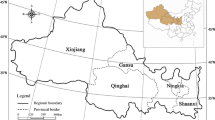Abstract
Two disadvantages of the entropy-weighting model (EWM) in drought-risk assessment are presented through two typical examples in this paper. (1) For distortion in the normalization process, entropy defined by EWM cannot represent the indicator’s dipartite degree correctly when too many zero values exist in the observation data. (2) Given that EWM neglects the indicator’s practical significance in drought-risk assessment, the indicator’s dipartite degree cannot correctly represent its importance when observation data are concentrated in the worst category. These two problems lead to unjustified drought-risk assessment results. Therefore, the features of observation data should be checked before weighting. If the indicator’s observation values are concentrated in the worst domain or numerous zero values exist, then EWM should be applied cautiously.
Similar content being viewed by others
References
Chang J, Li Y, Wang Y et al (2016) Copula-based drought risk assessment combined with an integrated index in the Wei River Basin, China. J Hydrol 540:824–834
Huang Z (2014) Evaluating intelligent residential communities using multi-strategic weighting method in china. Energy Build 69(69):144–153
Huang S, Chang J, Leng G et al (2015) Integrated index for drought assessment based on variable fuzzy set theory: a case study in the yellow river basin, China. J Hydrol 527:608–618
Liu L, Zhou J, An X et al (2010) Using fuzzy theory and information entropy for water quality assessment in three gorges region, china. Expert Syst Appl 37(3):2517–2521
Peng Y, Lai Y, Li X, Zhang X (2015) An alternative model for measuring the sustainability of urban regeneration: the way forward. J Clean Prod 109:76–83
Waseem M, Ajmal M, Kim TW (2015) Development of a new composite drought index for multivariate drought assessment. J Hydrol 527:30–37
Xu X (2004) A note on the subjective and objective integrated approach to determine attribute weights. Eur J Oper Res 156(2):530–532
Zhou Y, Xing X, Fang K et al (2013) Environmental efficiency analysis of power industry in China based on an entropy SBM model. Energy Policy 57(7):68–75
Zou ZH, Yun Y, Sun JN (2006) Entropy method for determination of weight of evaluating indicators in fuzzy synthetic evaluation for water quality assessment. J Environ Sci 18(5):1020–1023
Acknowledgements
This work is supported by the Natural Science Foundation of Water Resource Department of Hunan Government (No. 201524507).
Author information
Authors and Affiliations
Corresponding author
Electronic supplementary material
Below is the link to the electronic supplementary material.
Rights and permissions
About this article
Cite this article
Yi, F., Li, C. & Feng, Y. Two precautions of entropy-weighting model in drought-risk assessment. Nat Hazards 93, 339–347 (2018). https://doi.org/10.1007/s11069-018-3303-2
Received:
Accepted:
Published:
Issue Date:
DOI: https://doi.org/10.1007/s11069-018-3303-2




